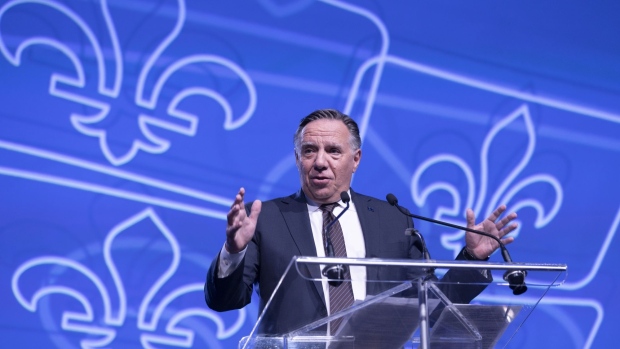Sep 27, 2022
A $4.7 Billion Mega-Tunnel Is Quebec Premier’s Grudging Priority
, Bloomberg News

(Bloomberg) -- Quebec Premier Francois Legault, on the verge of a decisive re-election victory, will begin his second term with a major challenge: how to deliver a multibillion-dollar project that many voters don’t want and that his government doesn’t intend to pay for entirely on its own.
Legault’s party, the Coalition Avenir Quebec, has a huge lead in polls over a divided opposition with less than a week until the Oct. 3 election and the premier looks set to return to power with a strengthened hand. Among his most expensive promises is a C$6.5 billion ($4.7 billion) tunnel underneath the St. Lawrence River in Quebec City, the capital of Canada’s second-largest province.
The five-mile tunnel would be a boon to engineering and construction firms and to drivers in a region that’s home to about 850,000 people. It would cut commute times by connecting the historic city directly with the suburb of Levis, less than 100 miles north of the US border at Maine.
But the project has also exposed some of Legault’s shortcomings as a politician, and he has caught sharp criticism from his opponents for keeping secret several studies on the tunnel idea.
“What do you have to hide?” Eric Duhaime, leader of the right-wing Parti Conservateur du Quebec, badgered Legault on one of Quebec’s most popular talk shows Sunday night. “Make the studies public. We have the right to know, the taxpayers paid for them.” Duhaime favors a bridge, which he says would be less expensive but could mar the vistas of Ile d’Orleans, a scenic island.
The CAQ has been polling around 40%, with the resurgent Conservatives and Dominique Anglade’s Liberals fighting it out for second place ahead of left-wing rivals Quebec Solidaire and the separatist Parti Quebecois. Seat projections by polling aggregator 338Canada show Legault winning 97 seats out of 125 next week, with Duhaime potentially shut out of the legislature despite his party’s surge in popular support.
Legault, 65, has already been forced to backtrack once. Until April, the government was leaning toward a tunnel nearly 20 meters wide (about 66 feet) -- more than double the width of Norway’s famous Laerdal Tunnel -- and carrying six lanes of traffic.
That ambition was too unwieldy and so was the estimated price tag of C$10 billion. The new proposal envisions two smaller tunnels side-by-side, each with two lanes of traffic.
Bruno Massicotte, professor of engineering at Polytechnique Montreal, did a technical study in 2016 for a potential tunnel in the region. The project would have faced significant challenges such as sandy soil, he found. The C$6.5 billion price tag on the latest version might again be understated, he said in an interview.
“It seems weak to me,” said Massicotte. “I have no idea how this amount was calculated.” A smaller tunnel dedicated only to public rail transportation could cost 8 to 10 times less, he added.
Legault argues that changes to the scope of the project make earlier studies irrelevant, and he concedes the final decision on the project will be a “political” one, anyway. The Quebec City region is one of his party’s strongholds: it won 8 of 11 seats there in the last election.
“We need a link and we propose a tunnel,” the premier has repeated on the campaign trail. At times, he has appeared frustrated with criticism of the project’s cost and the process. He even accused Montrealers of “looking down” on the residents of Quebec City and Levis.
But Legault’s main challenge might not be political but financial -- because his other promise is that taxpayers outside the province will help shoulder the cost. His his proposal is for 40% of the money to come from the federal government. And while no project has yet been officially submitted, the idea has received a cool reception in Ottawa.
©2022 Bloomberg L.P.


